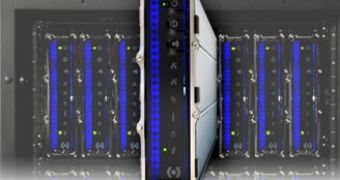At this year's Supercomputing conference, Hardcore Computer, a company specialized in building HPC systems, will showcase a series of servers that use dielectric liquid in order to cool the components found inside them.
Unlike regular water cooling systems, the Hardcore Computer servers are completely emerged in the so called Core Coolant.
This is possible since the dielectric liquid utilized by the company is non-conductive, non-volatile, biodegradable and has 1350 times better heat removal capacity by volume than air.
According to Hardcore Computers, in addition to decreasing the operating temperatures of the components found inside the machines, their liquid cooling solutions also have the advantage of reducing energy costs, compared to traditional data centers.
At the 2011 Supercomputing conference, Hardcore Computer will present its upcoming LSS 200 liquid submersion servers and Detonator workstations.
LSS systems mount directly into rack units and connect to the Core Coolant exchange system via dripless quick-connect fittings that allow for dielectric liquid to be pumped through the entire data center, thus eliminating the need for air conditioning equipment.
"With our advanced total liquid submersion technology, we provide industry professionals with innovative, power efficient, top-performing liquid submerged servers, workstations and desktop computers that deliver performance, reliability and quality never seen before in the marketplace," said Chad Attlesey, President, CTO and Founder, Hardcore Computer.
Outside of the system that it plans to present at the 2011 Supercomputing conference and that are expected to come out in the near future, Hardcore Computer is already selling a series of servers that rely on this cooling technology.
This is not the first time that dielectric liquid was used for cooling servers, as Cray has also taken a similar route when it developed some of its supercomputers in 1980, but is the first time that every single component inside a server is immersed in liquid.

 14 DAY TRIAL //
14 DAY TRIAL //